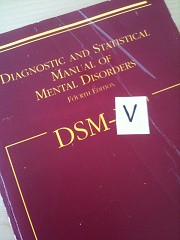
I’ve been meaning to cover the DSM-V, you know, the revised Diagnostic and Statistical Manual. But, as I said earlier, I’ve been too busy ruminating. Alas, here comes John McManamy with his own version. And I like this one a whole lot better than the approved version. To read John’s full post, click here. I feature an excerpt.
If you want anything done right, you have to do it yourself. With the DSM-5 task force and its various work groups and study groups a virtual walking and talking “How many psychiatrists does it take to change a light bulb?” joke, it is time for me to take matters into my own hands.
Following is a very rough draft to the first installment of “The People’s DSM,” which I am dedicating to the pioneering spirit of Robert Spitzer and those who worked with him on the ground-breaking DSM-III of 1980. Spitzer and company essentially ripped up the DSM-II and started over. Something the DSM-5 people should have done to the DSM-IV.
Something I’m doing right now. But I need your help. Please give me your feedback and suggestions and we’ll keep reworking it together till we get it right. On with the show …
Mood Disorders
DepressionIntroduction
The current depression diagnosis, with its antiquated symptom checklist, does not adequately account for extreme variations in emotions, thoughts, and behavior. Below are six domains to depression (such as emotion and thinking), each domain arranged in two complementary pairs, each pair with contrasting characteristics (symptoms or sets of symptoms).
These six domains would replace the symptom checklist.
For the Alternative Depression Diagnosis, clinicians need to check at least one characteristic from each domain. All four characteristics from a particular domain may be checked, even if they are opposite. As opposed to the previous DSM, this is not an exercise in symptom counting. More symptoms do not equate to a more severe depression.
Rather, this is an exercise in spotting symptom (characteristic) patterns and anomalies. Clustering of certain characteristics tends to resolve into one of two types of contrasting depressions: “Vegetative” and “Agitated”. There is also an intermediate “Mixed” depression.
All three may be called depression, but they are likely to demand entirely different and extremely subtle treatment and therapeutic approaches, as if they were different diseases. Current diagnostic practice does not encourage this.
A final note: Suicidal ideation is not included as a characteristic (symptom) here. This will be dealt with in a future installment.
Click here to continue reading.
To read Psychcentral’s John Grohol’s piece on the DSM-V, click here.

